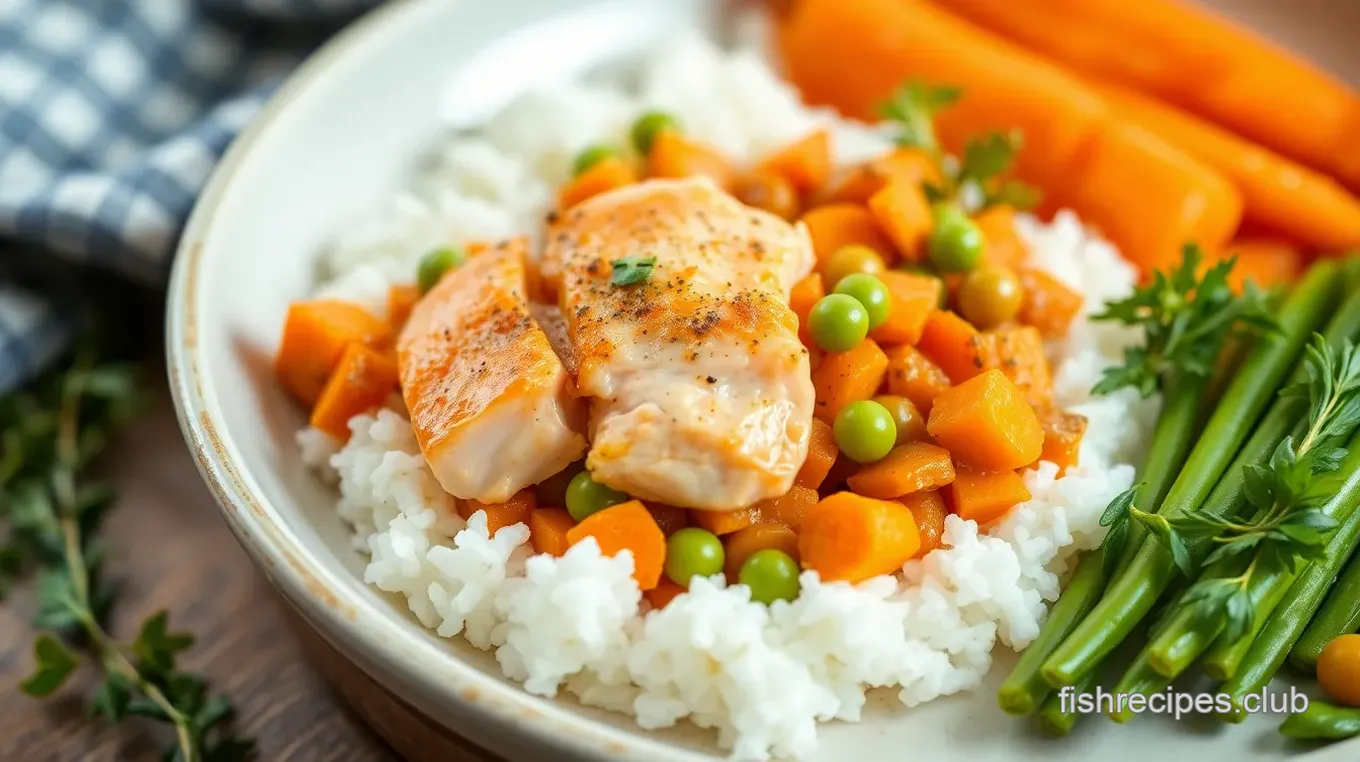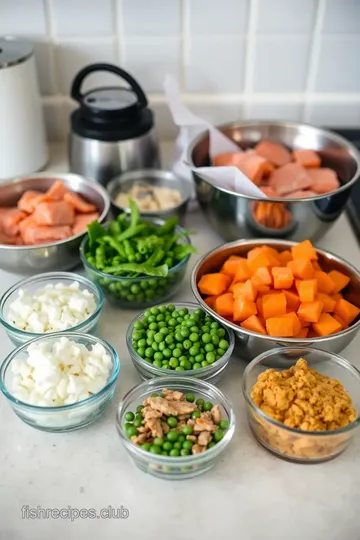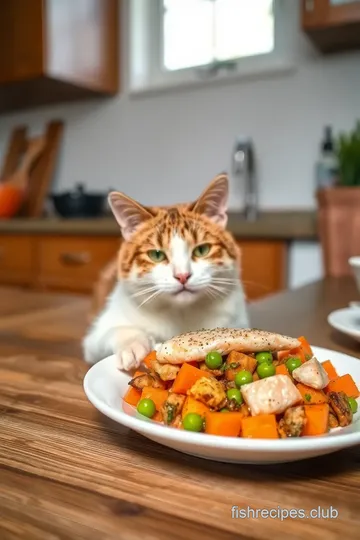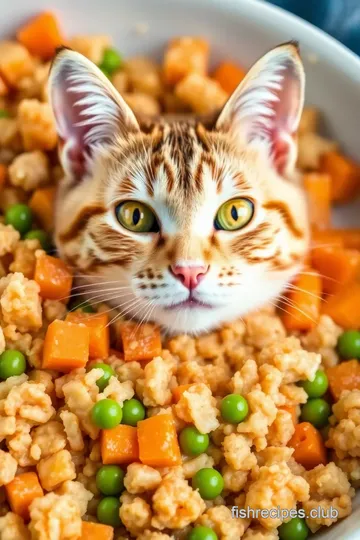Healthy Baked Fish Treats for Felines
Looking for the perfect Bake Fish Cat Food for Healthy Felines? My easy tuna treat recipe is delicious, healthy, and perfect for rewarding your kitty!

- Essential Ingredients Guide for Bake Fish Cat Food for Healthy Felines
- Unlocking the Secrets of Professional Cat Treat Cooking
- Pro Tips & Secrets for Your Fishy Feast
- Perfect Presentation: Making It Pawsome
- Storage & Make-Ahead Magic
- Creative Variations for Your Whiskered Wonders
- Complete Nutrition Guide for Healthy Felines
- Closing Considerations
- Frequently Asked Questions
- Recipe Card
Hey there, fellow cat lovers! so, imagine this: i’m chilling on the couch one saturday afternoon, scrolling through my phone, when suddenly i see my furry little monster, max, giving me that look.
You know the one, right? big eyes, soft purrs, and an “i’m starving, feed me” kind of vibe. well, i just couldn’t resist whipping up something special — and that’s how i struck gold with bake fish cat food for healthy felines .
Honestly, if you’ve got a hooman's best friend at home, you’ll want to keep reading.
Recipe Overview
Now, these baked fish treats aren't just another wannabe snack. they’ve got history! homemade cat treats have been around for ages, and the idea of cooking for your pet is really on the rise.
Everyone’s them — pets have gone gourmet! nowadays, folks are looking for healthy cat treats that are easy to make, and these little bites hit the spot.
Pretty cool, right?
These fishy delights only take about 35 minutes total . and don’t sweat it — they’re super easy to make! even if you’re not the next julia child, you’ll nail this recipe.
Plus, it won’t break the bank to whip up about 24 treats . you’ll score some serious points with your fur babies without emptying your wallet.
Key Benefits
Let’s dive into the good stuff. these treats are packed with nutrients. i mean, who wouldn’t want to give their cats the gift of omega-3 for cats ? those fatty acids are great for their skin and coat, helping them look fabulously well-groomed.
Say goodbye to pesky dander! plus, you can bet your bottom dollar that sticks with natural cat treats are a healthier option than those sketchy store-bought snacks.
We’ve all read the labels. yikes!
What’s even better? these baked fish snacks for cats are perfect for special occasions—whether it's a big “congrats on being so cute” day or “you survived the vet!” cheers.
Plus, you can play around with ingredients. you might want to add a bit of catnip for some extra fun or even change up the fish.
It’s all about what your kitty digs!
And let’s be real, there’s something heartwarming about cooking for your pets. it’s like crafting a little dose of love! with vet-approved cat treats like these, you can rest easy knowing you're doing what's best for them.
You know your kitty will appreciate those fresh cat food preparations more than any processed snack.
So, ready to get started? we can move on to the ingredient list and see what you need to whip up a batch of these tasty nuggets.
Trust me, your cat will be giving you that look of love every time!

Essential Ingredients Guide for Bake Fish Cat Food for Healthy Felines
When it comes to cooking for our furry friends, it’s all about using the right ingredients . whether you're whipping up homemade cat treats or some scrumptious fish snacks, it’s super important to know what you’re working with.
So grab a seat, and let’s dive into the essential ingredients that will help make those healthy baked fish treats for your felines !
Premium Core Components
First things first, let’s talk about the premium core components for creating treats like our baked fish snacks for cats .
- Detailed Measurements: You’ll usually see recipes in cups and ounces, but knowing your international measurements (like grams and liters) helps if you’re following a recipe from abroad. For our fish treats, you need 1 cup (90g) of canned tuna and 1 cup (120g) of oats .
- Quality Indicators: Look for canned fish packed in water, not oil—it keeps things healthier for your kitty! And for oats, choose the old-fashioned variety, as they’re less processed.
- Storage Guidelines: Keep your ingredients in cool, dry storage. Canned fish lasts a long time, but once opened, don’t forget to refrigerate it and toss it after five days.
- Freshness Tips: Always check for expiration dates on your ingredients. Fresh cat-friendly ingredients (like eggs and veggies) work wonders in your treats.
Signature Seasoning Blend
Now, you might think cats don't need seasoning—wrong! While cats can’t enjoy everything we love, you can still spice things up.
- Essential Spice Combinations: Adding a sprinkle of catnip to the dough not only adds flavor but gives your kitty a little thrill too!
- Herb Selections: Catnip is the superstar here, but you can try a little parsley for fresh breath!
- Flavor Enhancers: A drizzle of olive oil adds lovely moisture and helps keep the treats chewy.
- Regional Variations: Think about using other safe fish, like salmon or mackerel—experimenting can lead to tasty new treats!
Smart Substitutions
We all know that life is unpredictable, and sometimes you run out of ingredients. Here’s what to do.
- Common Alternatives: If you’re fresh out of tuna, canned salmon makes a fab alternative. It’s just as nutritious and delicious!
- Dietary Modifications: For a gluten-free cat snack , switch out oats for an alternative grain like ground rice.
- Emergency Replacements: No eggs? Unsweetened applesauce can bind your mixture together in a pinch!
- Seasonal Options: In summer, why not blend in some minced cooked zucchini? It’s refreshing and gives an extra kick!
Kitchen Equipment Essentials
Alright, time to talk shop—what do you really need for whipping up these easy cat recipes ?
- Must-Have Tools: A mixing bowl and a baking sheet are your best buddies. A food processor to blend those oats is a game-changer!
- Alternative Equipment Options: Got no cookie cutters? A regular knife can slice your treats into fun shapes without any drama.
- Preparation Tips: Make sure to preheat your oven to 350° F ( 175° C) so those treats bake evenly.
- Storage Solutions: Keep those wholesome cat snacks safe in an airtight container. You can store them in the fridge for a week—trust me, it’s better than store-bought!
So, those are your essentials for making Bake Fish Cat Food for Healthy Felines that are sure to keep your kitty purring and satisfied!
Ready to get cooking? Let’s get into the step-by-step instructions for making these tasty treats! You’re gonna love how easy it is, and I promise, your kitty will be begging for more!

Unlocking the Secrets of Professional Cat Treat Cooking
So, you’re ready to step up your cat treat game and whip up something truly special for your furry buddy? let’s dive into the world of professional cooking methods that’ll have your cat purring for more! we’ll explore how to bake fish cat food for healthy felines and ensure those treats are as nutritious as they are delicious.
Essential Preparation Steps
Mise en place is the fancy french term for having everything ready to go before you start cooking. imagine having all your ingredients lined up like a marching band—trust me, it makes the whole process smoother.
Start by measuring out your ingredients: 1 cup of canned tuna , 1 cup of oats , and a few others.
It’ll save you from hunting for that can opener mid-recipe—yikes!
Next up is time management . whenever i’m in the kitchen, i like to set timers. seriously, it’s a game-changer! for these baked fish treats, keep an eye on your oven around the 20-25 minute mark.
This gives you some leeway to tidy up while you wait—win-win!
Staying organized is key. One tip I swear by is using separate bowls for each ingredient. It sounds simple, but when you’re juggling eggs, fish, and oats all at once, trust me, it helps!
And don’t forget about safety considerations . When working with raw ingredients, always wash your hands and use clean utensils. We want our kitties to stay safe and happy!
Step-by-Step Process
Okay, let’s get cooking! Follow these easy-to-digest, numbered steps:
- Preheat your oven to 350° F ( 175° C) . This is crucial—don’t skip it!
- Prepare your ingredients. Drain and mash that canned tuna in a mixing bowl. If you’re blending your oats into flour, now’s the time!
- Combine everything in a bowl: that creamy tuna, the oat flour, the egg, olive oil, and the pumpkin puree. Mix it up until it’s a nice dough.
- Roll out the dough to about 1/4 inch thick . Use cookie cutters to make fun shapes for your cats. Who said cooking can’t be fun?
- Line a baking sheet with parchment paper and place those charming shapes on it.
- Bake for 20- 25 minutes until they look slightly golden and firm.
- Remove from the oven and let cool completely. You don’t want to serve hot treats—yikes!
Expert Techniques
When cooking for our felines, we want to ensure we hit the right star points.
Temperature control is essential. The treats should be crispy on the outside but chewy enough to be tempting for your cat. Pay attention to those 20- 25 minutes again!
Let’s talk about timing precision. If you bake your treats too long, they can turn into crunchy cat snacks, which might be okay, but we’re aiming for delightful here.
While we’re at it, find those visual cues for doneness . look for a slight golden hue and a firm feel.
If it looks like a cute little fish that can swim straight into your cat’s heart, you’re golden!
Success Strategies
Now, let’s avoid some classic pitfalls. a common mistake? baking directly without checking the oven's temperature. always use an oven thermometer.
Your treats may love to overbake if the oven is hotter than 350° f ( 175° c) .
Let’s chat about quality assurance . After baking, give one to your cat. Watch for those happy reactions!
For make-ahead options , these treats store well in an airtight container for up to a week in the fridge. You can always double the batch to freeze some for later!
Wrapping It Up
So there you have it! Now you’re equipped to put on your chef hat and bake some fabulous fish-based cat food that’ll keep those whiskers twitching with excitement.
Ready to take the plunge? remember, cooking for your furry friend isn’t just about the food; it’s about bonding and discovering new treats they’ll love.
Stay tuned for the last section where we’ll dive into more pet nutrition and cat-friendly ingredients to spice up those meals!

Pro Tips & Secrets for Your Fishy Feast
Alright, cat parents, let’s talk about making bake fish cat food for healthy felines ! this isn’t just about tossing fish in the oven.
Nope, it’s an art! here are some chef-approved secrets that’ll amp up your kitty cooking game.
Chef's Insights
One tip? always use high-quality canned fish. i mean, why go cheap when it’s about your fur baby? look for options packed in water with no added salt.
Trust me, your kitty will notice the difference, and those little noses know what’s good!
Time-Saving Techniques
Got another 10 minutes? make a double batch! just whip up a second round while the first one’s baking. that way, you’ll have treats ready for the week.
Plus, storing them means you get more cuddle time with your furball and less kitchen duty later on!
Flavor Enhancement Tips
Want to elevate those fish treats? sprinkle in some catnip ! not only does it make the mix more enticing, but it’s also a fun little burst of joy for your feline friend.
Who doesn’t love being a catnip-induced party?
Presentation Advice
Let’s be real: presentation matters even for cats. use fun shapes with your cookie cutters. you know, stars, fish, or whatever! it’ll jazz up treat time and make it feel special! and don’t forget to sprinkle a bit of fresh catnip on top.
It's like the cherry on the sundae but for kitties!
Perfect Presentation: Making It Pawsome
Plating isn’t just for fancy restaurants! When serving up these healthy cat treats , think like a pro.
Plating Techniques
Try putting the treats in a cute, shallow bowl. you could layer them with a fresh catnip garnish. this gives a fancy feel that will surely have them prancing around like they’re in a gourmet cat café.
Garnish Ideas
A sprinkle of catnip leaves? Yes, please! It adds both color and fun to the presentation. And honestly, if I were a cat, it’d make me feel like royalty!
Color Combinations
Think about using natural ingredients that pop! A hint of orange from pumpkin or a dash of green from catnip can really bring your overall treat vibe up a notch.
Visual Appeal Tips
Cats are curious creatures. So, if you make the presentation inviting, they’ll be excited to dig in. A visually appealing meal equals a cat that can’t wait to munch!
Storage & Make-Ahead Magic
So, you’ve baked a boatload of treats? Here’s how to keep them fresh and tasty!
Storage Guidelines
After those delicious morsels have cooled, pop them in an airtight container. They’ll last about a week in the fridge. Place them higher up to avoid those sneak attacks from cheeky paws!
Preservation Methods
If you really want to stock up, consider freezing them. just lay them out on a tray to freeze individually before transferring to a bag.
This way, you can toss a few out whenever your kitty’s looking for a healthy snack !
Reheating Instructions
If they’ve been stored in the fridge, a quick pop in the microwave for about 5 seconds is all it takes. Just make sure they’re not too hot before serving!
Freshness Duration
Homemade treats are best eaten fresh, but trust me, these goodies stay tasty for a while. just ensure you don’t leave them out for too long.
Cats aren't picky, but they do like things fresh!
Creative Variations for Your Whiskered Wonders
Tired of the same ol’ treat? Let’s mix it up!
Flavor Adaptations
Switch up the fish! If tuna's your cat’s jam, maybe try salmon next. Cats can be picky, so variety might just be the spice of kitty life!
Dietary Modifications
Got a cat with dietary restrictions? Substitute the oats for oat flour or even gluten-free flour . It’s all about keeping your kitty health-focused without sacrificing flavor!
Seasonal Twists
Think around big holidays! During Halloween, maybe add a bit of pumpkin for a fall twist. Your cat will appreciate the seasonal flair!
Regional Variations
Feeling adventurous? Look to popular cat cuisines from different regions. Maybe some herbs from Italian cooking or flavors from a traditional Japanese dish as a creative inspiration.
Complete Nutrition Guide for Healthy Felines
Now let’s dive into why these baked treats are a real win for your kitty.
Detailed Breakdown
Each fish treat packs 30 calories . With a good amount of protein and just a hint of fat, they’re the perfect balance for a snack.
Health Benefits
Omega-3 fatty acids from fish support a shiny coat and healthy joints. Your cat is going to be feeling like a million bucks after these!
Dietary Considerations
As with all things in life, moderation is key! These treats are healthy cat treats , but they shouldn’t replace their regular meals.
Portion Guidance
One or two treats a day is more than enough! Keep it simple and don’t overwhelm their little tummies.
Closing Considerations
So there you have it! with this recipe for bake fish cat food for healthy felines , you’re not just cooking; you're bonding.
Homemade cat food is a great way to show your love while providing your kitty with nutritional cat treats . so, get your paws dirty and start baking.
Your furry friend will thank you with endless purrs and cuddles! happy cooking!
Frequently Asked Questions
Can I use fresh fish instead of canned tuna for the Bake Fish Cat Food for Healthy Felines recipe?
Yes, you can use fresh cooked fish instead of canned tuna. Just ensure the fish is thoroughly cooked and free from bones, as these can be a choking hazard. This substitution may also enhance the flavor of the treats!
How should I store the baked fish treats to keep them fresh?
Store the baked treats in an airtight container in the refrigerator. They will stay fresh for up to a week. If you want them to last longer, consider freezing them and thawing individual pieces when needed.
What are some variations I can make to the Bake Fish Cat Food for Healthy Felines recipe?
You can substitute canned salmon for tuna for a different flavor, or even add finely chopped vegetables like spinach or carrots for extra nutrients. Experimenting with different fish options can also keep your cat's treats exciting!
Is it safe to give my cat these homemade treats every day?
While these treats are healthy, it’s important to feed them in moderation. Treats should only make up about 10% of your cat’s daily caloric intake to maintain a balanced diet. Always monitor your cat's response to new foods.
Can I use a different type of grain if I don't have oats?
Yes, you can replace oats with ground rice or another suitable grain for cats. Make sure whatever substitution you use is safe and palatable for your feline companion.
What cooking tips should I keep in mind while making the baked fish treats?
For best results, ensure all ingredients are well blended to form a consistent dough. You can also roll out the dough to about 1/4 inch thick for even baking. Use cookie cutters to create fun shapes that will delight your cat!
Healthy Baked Fish Treats for Felines Card

⚖️ Ingredients:
- 1 cup (90g) canned tuna in water, drained
- 1 cup (120g) oats, blended into a flour-like consistency
- 1 large egg
- 1 tablespoon (15ml) olive oil
- 1 tablespoon (15g) plain pumpkin puree (no additives)
- 1 tablespoon (5g) catnip (optional, for flavor and stimulation)
- Fresh catnip leaves for sprinkling (optional)
🥄 Instructions:
- Step 1: Preheat Your Oven: Set the oven to 350°F (175°C).
- Step 2: Prepare Ingredients: Measure and blend oats into a flour-like consistency if necessary. Drain and mash the canned tuna in a mixing bowl.
- Step 3: Combine Ingredients: Add the blended oat flour, egg, olive oil, pumpkin puree, and catnip (if using) to the tuna. Mix until a dough forms.
- Step 4: Shape Treats: Roll the dough out on a lightly floured surface to about 1/4 inch thick. Use cookie cutters or a knife to cut into desired shapes.
- Step 5: Prepare for Baking: Line a baking sheet with parchment paper. Place the shaped treats on the prepared baking sheet.
- Step 6: Bake: Bake in the preheated oven for 20-25 minutes until treats are firm and slightly golden.
- Step 7: Cool and Serve: Remove from oven and let cool completely before serving to your feline friend.
Previous Recipe: Easy & Juicy Grill Amberjack Fish with Lemon Herb Flavor: My Fail-Proof Herb Glazed Method
Next Recipe: Easy & Juicy Grilled Halibut Tacos with Fresh Slaw: My Family Favorite
